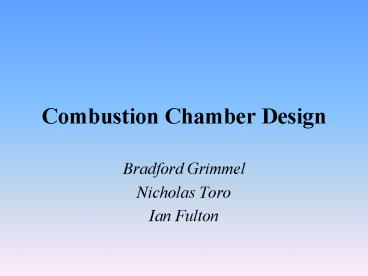Combustion Chamber Design - PowerPoint PPT Presentation
1 / 32
Title:
Combustion Chamber Design
Description:
Combustion Chamber Design Bradford Grimmel Nicholas Toro Ian Fulton Topics Combustion Chamber Defined Design Considerations Chamber Shapes Fast Combustion Volumetric ... – PowerPoint PPT presentation
Number of Views:1517
Avg rating:3.0/5.0
Title: Combustion Chamber Design
1
Combustion Chamber Design
- Bradford Grimmel
- Nicholas Toro
- Ian Fulton
2
Topics
- Combustion Chamber Defined
- Design Considerations
- Chamber Shapes
- Fast Combustion
- Volumetric Efficiency
- Heat Transfer
- Low Octane Requirement
- Knock
- Flow Inside A Cylinder
- Turbulence
3
Combustion Chamber Defined
- The combustion chamber consists of an upper and
lower half. - Upper half- Made up of cylinder head and cylinder
wall. - Lower half- Made up of piston head (Crown) and
piston rings.
4
Design Considerations
- Minimal flame travel
- The exhaust valve and spark plug should be close
together - Sufficient turbulence
5
Design Considerations
- A fast combustion, low variability
- High volumetric efficiency at WOT
- Minimum heat loss to combustion walls
- Low fuel octane requirement
6
Chamber Shapes
- A basic shapes
- Wedge - Hemispherical
- Crescent - Bowl in Piston
7
Chamber Shapes
- Wedge
- Asymmetric design
- Valves at an angle and off center
8
Chamber Shapes
- Hemispherical (Hemi)
- Symmetric design
- Valves placed on a arc shaped head
9
Chamber Shapes
- Bowl-in-Piston
- Symmetric design
- Valves are placed perpendicular to head
10
Chamber Shapes
- Crescent (Pent-Roof)
- The valves are placed at an angle on flat
surfaces of the head
11
Fast Combustion
- Effect of spark plug location
Side plug w/o swirl
Side plug with normal swirl
Side plug with high swirl
Central plug w/o swirl
Two plugs w/o swirl
12
Fast Combustionin Relation to Shape
13
Fast Combustionin Relation to Shape
14
Comparison of Burn Angles
15
Volumetric Efficiency
- Size of valve heads should be as large as
possible - Want swirl produced
16
Heat Transfer
- Want minimum heat transfer to combustion chamber
walls - Open and hemispherical have least heat transfer
- Bowl-in-piston has high heat transfer
17
Low Octane
- Octane Requirement related to knock
- Close chambers (bowl-in-piston) have higher knock
at high compression ratios than Open chambers
(hemispherical and pent-roof)
18
Octane Rating
- Research Octane Number (RON)
- Motor Octane Number (MON)
- Octane is one factor in the combustion process
that another group will speak about - Straight chain C-H bonds such as heptane have
weaker C-H bonds than branched chained C-H bonds
in branch chained HC such as iso-octane - Straight bonds are easier to break
19
Chemical Compositions
20
Knock
- Surface ignition
- Caused by mixture igniting as a result of contact
with a hot surface, such as an exhaust valve - Self-Ignition
- Occurs when temperature and pressure of unburned
gas are high enough to cause spontaneous ignition
21
Flow
- 2 types of flow
- Laminar flow
- Minimal microscopic mixing of adjacent layers
- Turbulent flow
- Characterized as a random motion in
three-dimensions with vortices (eddies) of
varying size superimposed on one another and
randomly distributed in the flow
22
Why Turbulence?
- Decrease burn time
- Reduces knock
- Reduces emissions (NOx)
- Allows for leaner mixture (stratified charge)
- Reduces emissions (HC)
- Decreases in combustion temperature
- Reduces knock
- Reduces emissions (CO)
- Reduces power
23
Inducing Turbulence
- Valve configuration and valve timing
- Turbulence generation pot
24
Characterizing Turbulence
- Eddies are defined by length scales
- The Integral Scale lI measures the largest
eddies of the flow field - The Kolmogorov scale lk measures the smallest
eddies - The Taylor microscale lm relates fluctuating
strain rate of flow field to intensity
25
Characterizing Turbulence
26
Characterizing Turbulence
- Swirl
- Axis of rotation is parallel to cylinder
- Generate swirl about valve axis (inside port)
27
Swirl
- Impulse Swirl Meter
- Honeycomb flow straightener measures total torque
exerted by swirling flow. - A swirling ratio is defined
- Rs?s/2?N
- This ratio is the angular velocity, ?s, of a
solid-body rotating flow (equal to angular
momentum of actual flow) divided by the
crankshaft angular rotational speed
28
Swirl
29
Characterizing Turbulence
- Tumble
- Axis of rotation is perpendicular to cylinder
axis - Associated with swirl
30
Characterizing Turbulence
- Rt is the tumble ratio,
- Rt?t/2?N
- This ratio compares the angular velocity,
- ?t, of the solid-body rotation with same angular
momentum as actual velocity distribution in
tumble to angular velocity of the crankshaft (N)
31
Squish
- Radially inward gas motion that occurs toward end
of compression stroke
32
Conclusion
- Optimum chamber
- Central spark plug location
- Minimum heat transfer
- Low octane requirement
- High turbulence































